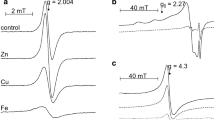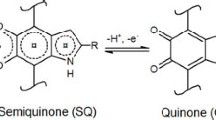Abstract
Detailed studies on dielectric and electric properties of synthetic pirocatechol and indolederived melanin, pure and doped with Eu3+, have been performed, D.C. and a.c. electrical conductivity as well as dielectric permittivity and loss angle tg have been investigated. Activation energy of d.c. conductivity for the investigated temperature range (0°C<T<50°C equals 0.63 eV for pirocatechol and 0.62 eV for indolemelanin. Europium ions Eu3+ doped to the samples do not influence the values of activation energy, but the addition of Eu3+ ions decreases the conductivity values. On the basis of depolarization current curves the energy of trap level referred to Eu3+ has been calculated. It equals 0.58 eV for pirocatechol and 0.60 eV for indolemelanin.
Similar content being viewed by others
References
Barr, F.:Medical Hypoth. 11 (1) (1983), 1–140.
Informal Meeting on Biophysics and Biological Functions of Melanins, Parna, March (1980) 3–4.
Mc Ginnes, J.E.: Mobility gaps: A mechanism for band gaps in melanins,Science 177 (1972), 896–897.
Strzelecka, T.: Band model for synthetic DOPA-melanin,Physiol. Chem. Phys. 14 (1982), 219–222.
Strzelecka, T.: A hypothetical structure of melanin and its relation to biology,Physiol. Chem. Phys. 14 (1982), 333–337.
Osak, W., Tkacz, K., Czternastek, H., and Sławiński, J.: I–V Characteristics and electrical conductivity of synthetic melanin,Biopolymers 28 (1989), 1895–90.
Ishay, J.S. and Shimony, T.B.: Temperature dependence of the electric resistivity of the hornet cuticle,J. Theorem. Biol. 7 (1982), 91–94.
Rosenzweig, E., Fuchs, C. and Ishay, J.S.: Electrical resistance of hornet cuticle: Changes induced by xanthines-A statistical model,Physiol. Chem. Phys. and Med. NRR 17 (1985), 435–449.
Jastrzebska, M., Dworzanski, J.P. and Wilczok, T.: Dark and photo-conductivity of synthetic pheomelanins,Studia Biophys. 129 (1989), 83–90.
Strzelecka, T.: Semiconductor properties of natural melanins,Physiol. Chem. Phys. 14 (1982), 223–231.
Baroldi, P., Cappelletti, R., Crippa, P.R. and Romeo, N.: Electrical characteristics and electret behaviour of melanin,J. Electrochem. Soc. 126 (1979), 1207–1212.
Osak, W., Tkacz, K., Czternastek H. and Sławiński J.: Dielectric relaxation in synthetic melanin,Biopolymers 28 (1989), 1875–1883.
Mc Ginnes, J.E., Corry, P., and Proctor, P.: Amorphous semiconductor switching in melanins,Science 183 (1974), 853–855.
Filatov, J., Mc Ginnes, J.E., and Corry, P.,Biopolymers 15 (1976), 2309–2312.
Pullman, B. and Pullman, A.: The band structure of melanins, inQuantum Chemistry, Academic Press, New York, 1963, p. 497.
Galvao, D.S. and Caldas, J.M.: Polymerization of 5,6 Indole quinone: A view into the band structure of melanins,J. Chem. Phys. 88 (1989), 4088–4091.
Bridelli, M., Capelletti, R., and Crippa, P.R.: Electret state and hydrated structure of melanins,Bioelectrochem Bioenerget. 8 (1981), 555–567.
Trukhan, E.M., Deryabkin, V.N., and Ostrovsky, M.A.: Investigation of photoconductivity of eye pigment epithelium,Biofizika 18 (1973), 392–394.
Trukhan, E.M., Perevoschikoff, N.F., and Osrovsky, M.A.: The photoconductivity of pigment epithelium of the eye,Biofizika 15 (1970), 1052–1054.
Crippa, P.R., Cristofoletti, V., and Romeo, N.: A band model for melanin deduced from optical absorption and photoconductivity experiments,Biochem. Biophys. Acta 538 (1978), 164–170.
Kurtz, S.K., Kozikowski, S.D., and Wolfram, L.J.: Electro-optical and photorefractive materials, in Gtnter, P. (ed.)Electro-Optical and Photorefractive Materials, Proc. Int. School on Materials Science and Technology, Erice, Italy, Springer-Verlag Berlin, 1986, p. 110–130.
Pethig, R.:Dielectric and Electronic Properties of Biological Materials, Wiley, London, 1979.
Jafary, A.H.-ASL, Solanki, S.N., Aarholt, E., and Smith, C.W.: Dielectric measurements on live biological materials under magnetic resonance conditions,J. Biol. Phys. 11 (1983), 15–22.
Chakraborty, D.P., Roy, S., and Chakraborty, A.: Melanin from indole under undenfriend condition, Informal Meeting on Biophysics and Biological Functions of Melanins, Parma, Conference Proceedings, 1980.
Chakraborty, D.P., Chowdhury, Roy, S.K., Dey, R.N., and Chatterje, A.,Clinica Chimica Acta 82 (1987), 55.
Bogacz, A., Buszman, E., and Wilczok, T.: (1) Competition between metal ions for DOPA-melanin (2) Metal ions binding to DOPA-HSA complexesStudia Biophys. 127 (1988), 103, 127.
Stepien, K.B., Dworzanski, J.P., Bilinska, B., Porebska-Budny, M., Hollek, A.M., and Wilczok, T.: Catecholamine melanins Structural changes induced by copper ions,Biochem. Biophys. Acta 997 (1989), 49–54.
Bagirov, R.M., Stukan, R.A., Dontsov, A.E., Ostrovski, A.M., and Lapina, V.A.: Gamma resonance spectroscopic study of ferrum ions binding by melanoprotein granules of the eye pigment epithelium,Biofizyka 31 (1986), 469–474.
Sławiński, J., Paetz, M., and Elbanowski, M.: Luminescent Investigations of Eu2+/Eu3+ ions-melanin system, in Jezowska-Trzebiatowska B., Lagendziewicz J. and Strek W. edsExcited States of Transitions Metals World Scientific, Singapore, 1989, p. 472–477.
Elbanowski, M., Paetz, M., and Sławiński, J.: Chemiluminescent reactions of the systems: Eu2+/Eu3+ ATP or ADP, AMP, C-AMP-H2O2 of Biological Interest, in Jezowska-Trzebiatowska B., Lagendziewicz J., and Strek W. (eds.),Rare Earths Spectroscopy World Scientific, Singapore, 1985, p. 443–448.
Elbanowski, M., Paetz, M., Sławiński, J., and Cieśla, L.: Chemiluminescence and fluorescence of the europium ions-nucleotides system and its possible biological significance,Photochem. Photobiol. 47 (1988), 463–466.
Sarna, T., Hyde, J.S., and Swartz, H.M.: Ion-exchange in melanin: An electron spin resonance study with lanthanide probes,Science 192 (1976), 1132–1134.
Jonscher, A.K.: Presentation of dielectric functions, p. 2–114, Experimental evidence on the Time Response, p. 254–292, inDielectric Relaxation in Solids, Chelsea Dielectric Press, London, 1983, Ch. 3 and 6.
Dissado, L.A., Hill, R.M.: The fractal nature of the cluster model dielectric response function,J. Appl. Phys. 66 (1989), 2511–2524.
Niklasson, G.A.: Comparison of dielectric response function for conducting materials,J. Appl. Phys. 66 (1989), 4350–4359.
Macdonald, J.R.: Linear relaxation: Distribution, thermal activation structure and ambiguity,J. Appl. Phys. 62 (1987), 51–62.
Ngai, K.L., Jonscher, A.K., and White, C.T.: On the Origin of the universal dielectric response in condensed matter,Nature 277, 185–189.
Pfister, G. and Scher, H.: Time-dependent electrical transport in Amorphous Solids: As2Se3,Phys. Rev. B 15 (1977), 2062–2083.
Cole, R.H.: Molecular correlation function approaches to dielectric relaxation, in Goodman, C.H.L. (ed.),Physics of Dielectric Solids The Institute of Physics Bristol and London, 1980, p. 1–21.
Calderwood, J.H.: Lows-governing dielectric relaxation,J. Phys. C Solid State Phys. 16 (1983), L301-L303.
Hill, R.M. and Dissado, L.A.: The temperature dependence of relaxation processes,J. Phys. C Solid State Phys. 15 (1982), 5171–5193.
Weron, K.: A probabilistic mechanism hidden behind the universal power low for dielectric relaxation. General relaxation equation,J. Phys. Condens. Matter 3 (1971), 9151–9162.
Wintle, H.J.: Absorption currents and steady currents polymer dielectrics,J. Non-Crystall. Solids 15 (1974), 471–486.
Osak, W. and Tkacz, K.: Long-lasting relaxation current in TGS,Phys. Stat. Sol. (a) 100 (1987), 667–672.
Seanor, D.A. (ed.),Electrical Properties of Polymers, Ch. 1: Electrical conduction in polymers Academic Press, New York, 1982, p. 1–58.
Sarna, T.: Ion-exchange studies in melanins Seiji, M. (ed.) inProc. XI Internat. Pigment Cell Cong., Sendai, Japan, Univ. of Tokyo Press, 1981.
Thathachari, Y.T. and Blois M.S.: Physical studies on melanins. II. X-ray diffraction,Biophys. J. 9 (1969), 77–89.
Author information
Authors and Affiliations
Rights and permissions
About this article
Cite this article
Osak, W., Tkacz-Śmiech, K., Elbanowski, M. et al. Dielectric and electric properties of synthetic melanin: the effect of europium ions. J Biol Phys 21, 51–65 (1995). https://doi.org/10.1007/BF00701009
Received:
Accepted:
Issue Date:
DOI: https://doi.org/10.1007/BF00701009




